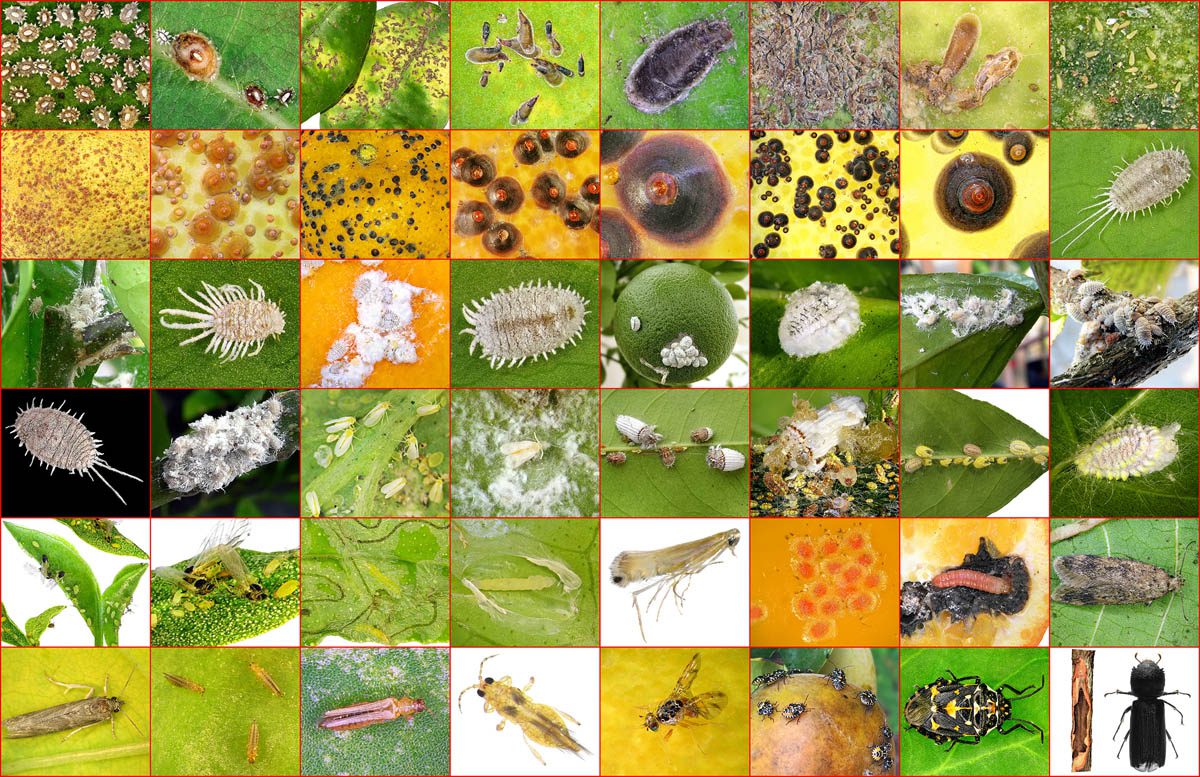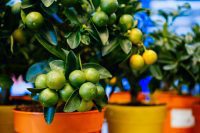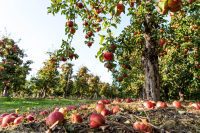As a home gardener with a lot of fruit trees, I have found citrus to be one of the easiest species of fruit tree to grow in our subtropical climate. But, as with all plants, citrus can be affected by pests which can greatly impact their health and reduce fruit quality and quantity.
Citrus pests
African citrus psyllid
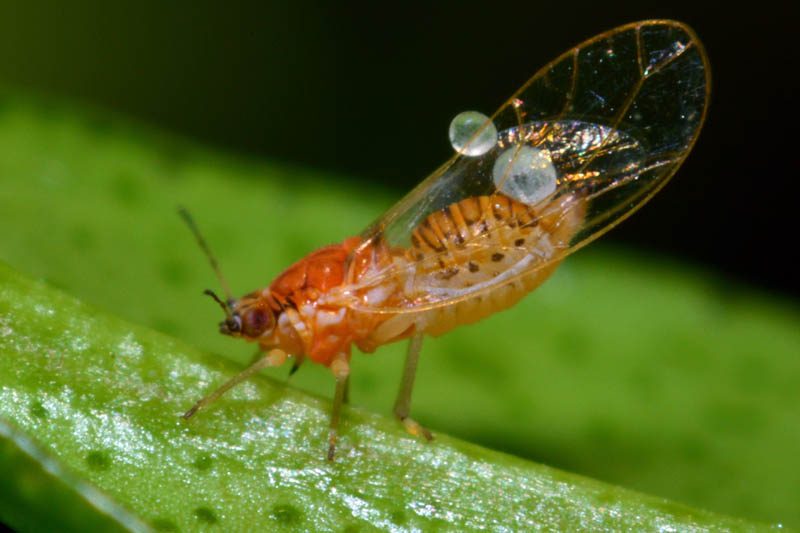
African citrus psyllid (Trioza erytrea) is a sap-sucking insect native to southeastern Africa. African citrus psyllid causes direct damage to the plant and can transmit the lethal Huanglongbing (yellow dragon disease, previously known as citrus greening disease).
Distribution:
Affected regions include sub-Saharan Africa; Saudi Arabia; Yemen; the Indian Ocean islands of Madagascar, Mauritius and Reunion; and the Atlantic Ocean islands of Saint Helena, Madeira, Porto Santo, Tenerife and Gomera.
Life cycle:
Infestation occurs via natural dispersal as well as commercial trade of affected plants. Adult African citrus psyllids are 2.5 – 4mm long, with a brown body, black head and large, transparent wings with clearly defined veins. A female can lay up to 2,000 eggs on the margins of new leaves. Both larvae and adult African citrus psyllids feed on citrus leaves, and as they do, they inject a toxin.
Infestation occurs during spring, and the complete life cycle is over within 45 days. Signs of infestation include galls (pits) on affected leaves, distorted leaf growth, a premature drop of young flowers, stunted growth, and dieback. Psyllids excrete a white sugar-rich sticky substance called honeydew, which may be visible on the leaves and surrounding the tree.
Treatment:
Contact your local government authority if you suspect your citrus has African citrus psyllid. They will be able to confirm the presence of African citrus psyllid and provide guidance on how to manage the infestation.
Asian citrus psyllid

The Asian citrus psyllid (Diaphorina citri) is similar to the African citrus psyllid, as a sap-sucking insect and vector for Huanglongbing.
Distribution:
Native to Asia, the Asian citrus phyllid is now found in the Middle East, South and Central America, Mexico, and the Caribbean.
Life cycle:
Adult Asian citrus psyllids are approximately 4 mm in length with a mottled brown body, light brown head and mottled wings. A waxy secretion covers the body.
Larvae and adults feed on the sap of young citrus leaves and shoots, during which, they produce honeysuckle, which coats the leaf which blocks sunlight and encourages sooty mould.
Treatment:
Contact your local government authority if you suspect your citrus has Asian citrus psyllid.
Citrus leaf miner
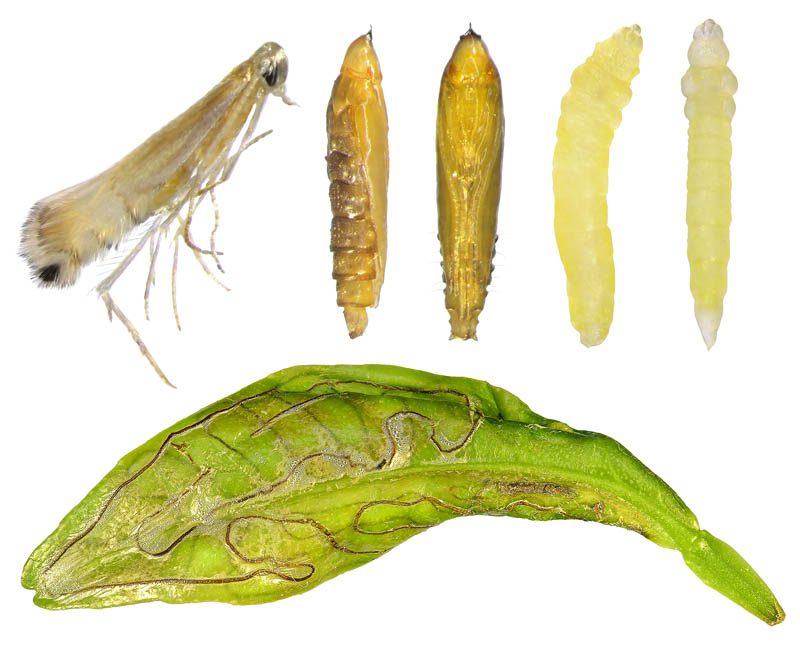
Citrus leafminers (Phyllocnistis citrella) are the larvae of a small silvery-white nocturnal moth native to southern Asia. The adult moth doesn’t damage the citrus tree, only the lavae pose a risk. Infestations are most common in late summer.
Distribution:
Citrus leafminers can be found in Asia, Australia, north and south America, Africa and the Mediterranean basin.
Life cycle:
Adult moths lay their eggs on the underside of citrus leaves. Once hatched, larvae tunnel under the surface of young citrus leaves, forming shallow channels, causing distortion of the leaves and stunted growth. Larvae go through three larval stages (instars) before they pupate inside a citrus leaf by folding it over. Pupation takes 1 – 3 weeks before the adult moth emerges.
Treatment:
Remove any affected leaves, place them in a plastic bag and dispose of them in the garbage. Do not place in compost, which will allow the larvae to pupate. Products containing neem oil can disrupt the life cycle of citrus leafminer, and products with the active ingredient spinetoram can kill larvae within the leaf.
Citrus fruit borer
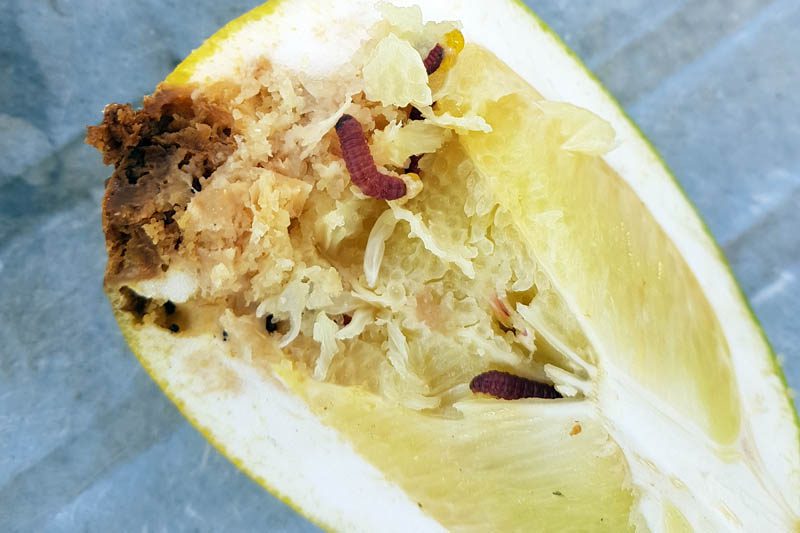
Also known as citrus pulp borer, citrus fruit moth and lemon fruit borer, the citrus fruit borer (Citripestis sagittiferella) is a subtropical and tropical species of snout moth native to Indonesia, Malaysia, Singapore, Vietnam and Thailand. The adult moth is 10mm long brown/grey with brown forewings and translucent hindwings.
Distribution:
Indonesia, Malaysia, Singapore, Vietnam and Thailand.
Life cycle:
The adult moth lays her eggs in clusters on the surface of citrus fruit. Once the eggs hatch, they burrow into the rind, and after the first moult, they dig into the pith and through to the pulp, causing rotting and fruit drop. Once they have reached their final moult, the 16mm long larvae leave the fruit and pupate in the soil.
Treatment:
Contact your local government authority if you suspect your citrus has citrus fruit borer.
Citrus mealybug
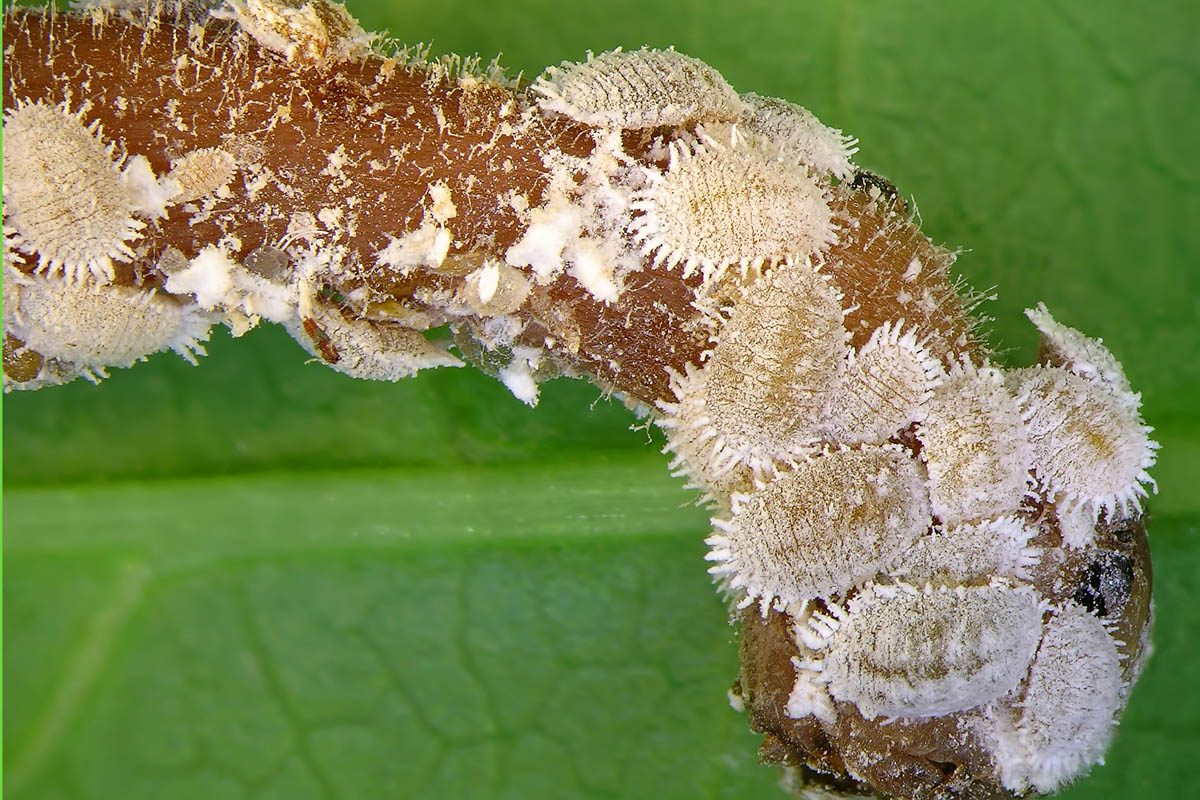
Citrus mealybug (Planococcus citri) are one of the most common insects to infest citrus trees. Native to Asia, these small, flat, segmented insects. The body of the female mealybug is covered in a white powdery wax material, extending into filaments (spines) along the body margin.
Distribution:
Worldwide.
Life cycle:
The adult mealybug lays her eggs covered in sticky wax ovisac (an envelope made of silk that encloses the eggs) on the trunk and stems of citrus trees. Nymphs (known as crawlers) hatch from the eggs within a week. Adult females and nymphs feed on sap with their piercing mouthparts, which damages the plant and causes chlorosis (yellowing) of the foliage, as well as leaf drop, stunted growth and reduced crop yields. As the female and nymphs feed, they secrete honeydew, which can lead to sooty mould, a fungus that feeds on honeydew.
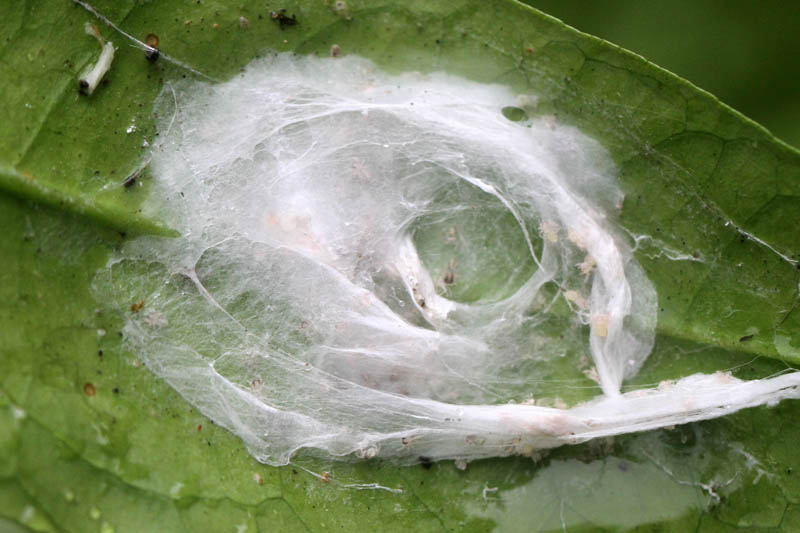
Treatment:
Maintaining beneficial insects such as the mealybug ladybird (Cryptolaemus montrouzieri), lacewing larvae (Oligochrysa lutea) and parasitic wasp, Leptomastix dactylopii. Keep ant populations down as they feed on the sugar-rich honeydew and in return protect citrus mealybug.
Mealybugs can be difficult to control with chemicals due to their resistance, waxy coating and their natural tendency to hide.
Queensland fruit fly
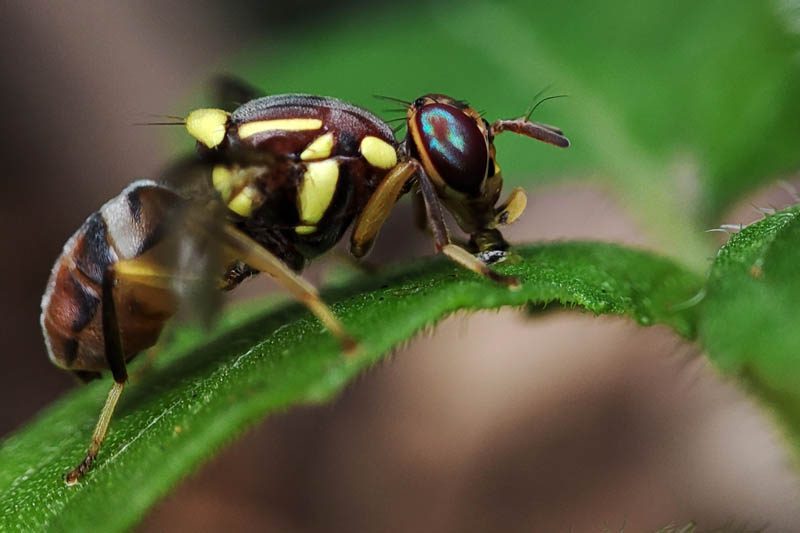
Queensland fruit fly (Bactrocera tryoni) is a wasp-like fly, with brown and yellow markings. Native to subtropical coastal Queensland and northern New South Wales, the Queensland fruit fly is responsible for significant crop losses across a wide range of fruits. Adult fruit flies are most active in humid conditions and after rain.
Distribution:
Eastern Australia.
Life cycle:
There are four stages to the Queensland fruit fly life cycle, egg, larvae, pupae and adult. Adult Queensland fruit flies are most active from October to May. The adult female has an egg-laying organ known as an ovipositor, which she uses to dig a 3 mm deep chamber into the outer layer of ripe fruit, in which she will lay her eggs. After 2 – 4 days, larvae emerge and eat their way towards the inside of the fruit, leading to rot. Eventually, the larvae crawl out of the gruit and burrow into the ground where they develop into pupae. After several weeks, the fruit fly emerges from the ground as adult flies.
Treatment:
- Monitor: Hang sticky traps to monitor and catch adult fruit flies.
- Lure and kill: A method that uses bait to attract adult fruit flies which are then killed with insecticides or traps.
- Exclusion: Use a fine mesh net as a physical barrier against Queensland fruit flies. Either the entire tree is covered, or individual fruit. Organza gift bags make an ideal cover to protect the fruit.
- Insecticides: Use an approved insecticide.
Red scale
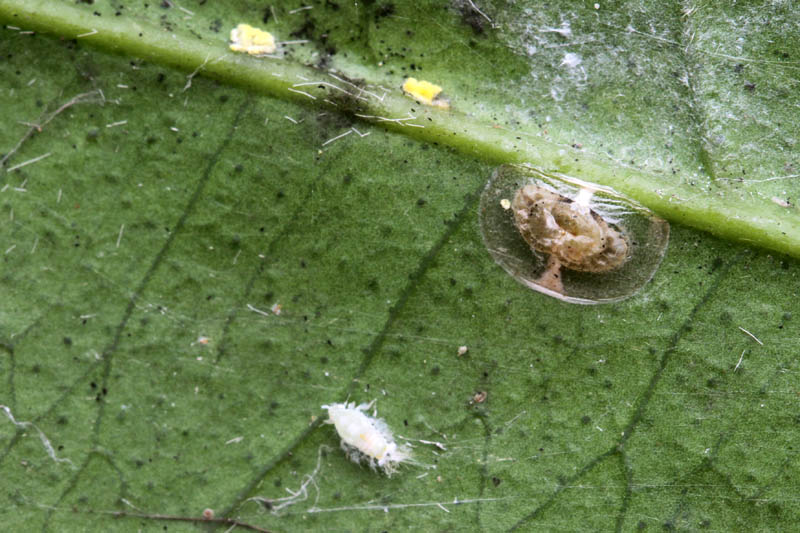
Also known as California red scale, red scale (Aonidiella aurantii) is a sap-sucking scale insect and one of the most common types of scale to infest citrus trees. The light brown, shield-shaped insect is completely unable to move and is attached to the tree by a leathery protective scale. As they feed, honeydew drips from the body, resulting in sooty mould.
Distribution:
Red scale is believed to have originated in China but is now present in all countries where citrus grows.
Life cycle:
The male has four life stages while the female has five. The adult female gives birth to 2-3 live ‘crawlers’ per day over a 6 – 8 week period. The yellow crawlers emerge from the mother’s scale, settle nearby, and use its mouthparts to attach to a leaf, shoot or fruit. During this stage, they go through several moults. The males emerge as tiny winged insects, while the females remain in their protective covering.
Treatment:
Parasitic wasps (Aphytis lignanensis and Aphytis melinus), ladybirds, chilocorus beetles and predatory mites are used to control red scale populations. Parasitic wasps are commercially available. Sticky traps with synthetic red scale pheromones can be used to monitor for the presence of flying red scale. Movento is an insecticide produced by Bayer that is effective against red scale.
Citrus rust mite

Also known as silver mite, citrus rust mite (Phyllocoptruta oleivora) is a microscopic mite that infests leaves, fruit and twigs of citrus trees in humid regions, causing damage, especially to fruit which occurs to the outside of the fruit, impacting its appearance. If damage occurs early in the season, damage to the peel is referred to as russeting, and takes on a bronze appearance. Infestation also causes a silvering of the peel in lemons and grapefruit, reduced fruit quality and increased fruit drop.
Distribution:
Asia, Africa, North, South and Central America, the Caribbean, Europe and Oceania.
Life cycle:
The female lays her eggs in pits on fruit, or on leaves and cracks in the bark. Eggs hatch into nymphs within three days, with a similar appearance to the adult, only smaller, a second nymph molt occurs two days later, and finally the adult mite emerges. Adults are so small they are invisible to the human eye.
Mites are present year-round, but are in their highest populations are present in early to mid-summer.
Treatment:
Mind infestations can be managed with predatory mites (Amblyseius species). Heavy infestations may benefit a white oil/dishwashing solution diluted in water, lime sulphur (polysulphide sulphur) or wettable sulphur.
Citrus snow scale
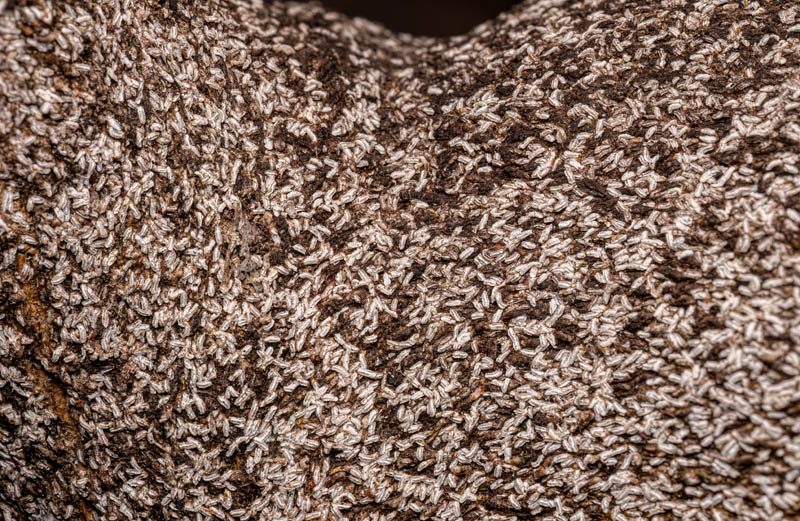
Citrus snow scale (Unaspis citri) is a species of armoured scale insect native to Asia, that predominantly lives on the trunk of citrus trees, although heavy infestations can involve the twigs, leaves and fruit. The female has a brown oyster like appearance, is 2mm long. She may not be noticeable on the trunk of the affected tree due to her colour. Adult females insert their mouth parts into the tree, form their protective cover and become sessile (fixed). The male is smaller, at 1mm long, and is white, hence the name ‘snow scale’.
A heavy infestation can lead to leaf drop, twig dieback and a splitting of the trunk, which exposes it to other pathogens. The saliva injected into the tree is toxic, producing necrotic areas around the site, dieback of twigs and eventual death of the branch.
Distribution:
Citrus snow scale is found in North, Central and South America, Africa and Oceania.
Life cycle:
Citrus snow scale can produce between 3 – 6 generations a year. The adult female lays round, orange eggs, which hatch into instars and move to other crevices on the tree, forming a protective scale over their body. Females moult four times, compared to males who only moult twice.
Treatment:
Natural predators include wasp species Aphytis lingnanensis and Aspidiotiphagus lounsburyi and in Australia, the predatory caterpillar, Batrachedra spp.
Stink bugs
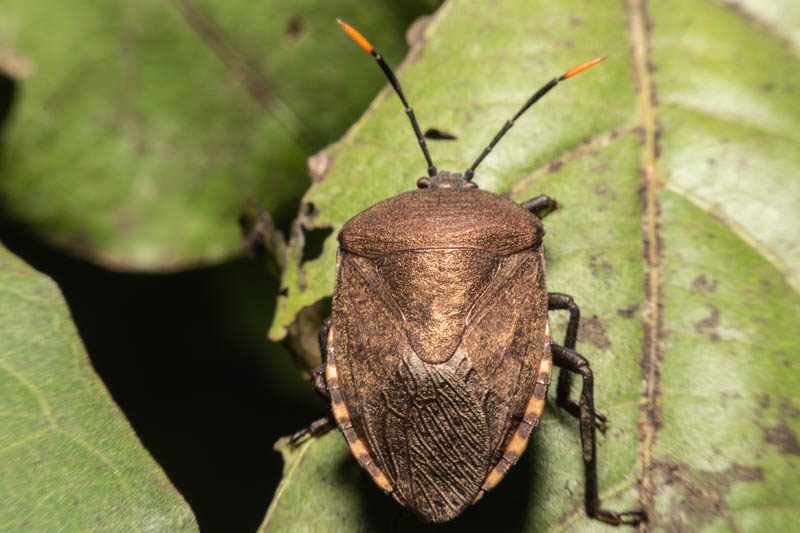
Stink bugs are insects that belong to the family Pentatomidae which is made up of 4,700 species of six-legged, flat-bodied insects. They are known for the unpleasant odour they emit when threatened or disturbed. These sap-sucking plant-feeders and are considered agricultural pests, as they feed on the sap of young shoots and flower stems causing them to die. They have a shield-shaped body and can vary in colour, but are typically green or brown.
Distribution:
Stink bugs are native to Asia, but are widespread throughout the world including Oceania, Europe, and North and South America.
Life cycle:
The stink bug life cycle is made up of three stages: egg, nymph, and adult. Stink bugs mate in spring, as the weather warms up. The eggs are usually laid in clusters on the undersides of leaves, and hatch into nymphs within a week. Nymphs resemble small versions of adult stink bugs, but do not have fully developed wings. They undergo several molts as they grow, and eventually become adults. The entire life cycle from egg to adult can take anywhere from 4 to 6 weeks, depending on the species and environmental conditions. Adult stink bugs can live for several months.
Treatment:
The simplest and most environmentally friendly way to kill stink bugs is with hot water and washing detergent. It is important to wear protective clothing (long sleeves and pants), gloves and eyewear as stink bugs spray a corrosive substance.
Resources
For Australian readers, Bugs for Bugs sell a large number of predatory insects to control pests on citrus trees. Where possible, look for non-chemical methods before reaching for insecticides, which can harm helpful insects, which include bees.
Julia is a writer and landscape consultant from Wollongong with a love of horticulture. She had been an avid gardener for over 30 years, collects rare variegated plants and is a home orchardist. Julia is passionate about learning and sharing her knowledge of plant propagation and plant toxicology. Whether it’s giving advice on landscape projects or sharing tips on growing, Julia enjoys helping people make their gardens flourish.
